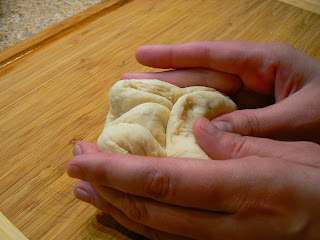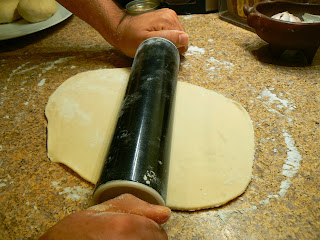Udon noodles are a thick, perfectly chewy Japanese noodle. As an adult, when I first had udon, it reminded me of the thick, pillowy noodles my Grandmother would put in her chicken soup. A great toothsome noodle is comfort food, no matter where you're from. I didn't get to learn my Grandmother's noodle recipe, but I bet the ingredients were a hell of a lot like the ones from this classic udon recipe.
**this recipe requires the dough to rest for two hours**
What you need:
**this recipe requires the dough to rest for two hours**
What you need:
500 grams/1.1 lbs/2 cups plus 2 tablespoons high-gluten bread flour*
1 Tbsp salt
1 cup water, room temperature
*if you only have all-purpose, that's totally ok. The extra gluten is great, but they'll be just as tasty with "regular" flour
Completely dissolve the salt in the water. I mean completely. Sift your flour into a big mixing bowl, then add the salted water:
Mush it around with your hands until it forms a dough. It should stick together as one piece, even if it seems a little dry. Depending on where you live, the temperature, measurements, and whatnot, you may need to add more water. We had to add a couple more tablespoons or so. Don't worry if it's a bit dry. It should look something like this:
Now here's the fun part. Put your dough in one of those giant Ziploc bags (or, if you're poorly prepared like we are, divide the dough in 3 and use 3 regular quart-sized bags). Squeeze every bit of air out of the bag that you can, then lay the bagged dough on the ground and step on it with socked feet. You could squish it flat with your hands, but the extra pressure of your whole body's weight makes the flattening task easy and quick.
YOU'RE NOT DONE STOMPIN' MISTER (OR MISSY)!!!
Put the rolled-up dough back in the bag, make it as air-tight as you can (again) and flatten it again with your mighty feets. Pull it back out, roll it up, and do it again, until you have stomped your dough 6 or 7 times total. When you're finished, get the dough back out of the bags. It should be kind of stiff and rubbery. Leave it alone for ten minutes. In the meantime, pet your cats (I KNOW YOU HAVE CATS) and make yourself a drink. After ten minutes, it's time to roll up the dough. Grab the corners and gather them into a ball, like so:
Now roll it into as spherical a ball as you can:
TA-DAAAAAA!
Once your two hours are up, it's time to prepare your dough-rolling space by adding a layer of potato starch (Katakuri-Ko) or corn starch to your counter top and rolling pin.
Now cover your dough ball (or balls if you are poor planners like us) and leave them alone for two hours. Go have a drink. By a drink, I mean a few drinks. These two hours are a perfect time to figure out what the fuck you are actually going to do with this noodle you've decided to make (if you haven't already). You can pan-fry udon with meat or veg or both, or add it to soup. Thinly sliced rare steak pieces and asparagus and garlic would be awesome, sauteed with udon. Or whatever. You are the master of your own destiny.
Once your two hours are up, it's time to prepare your dough-rolling space by adding a layer of potato starch (Katakuri-Ko) or corn starch to your counter top and rolling pin.
Roll the dough out into a thin sheet (appx 1/8 in uniform thickness). Sprinkle it with more potato starch, and fold it in half, more potato starch, then half again and so on.
Now, slice it into thin pieces (about 1/4 to 1/8 in depending on preference) like so:
Unravel them, and now you have beautiful fresh udon noodles! They are best cooked as soon as possible. No matter what you do with them, they need to boiled for 8-10 minutes in water or broth, like any kind of noodle/pasta. From there you can pan fry them to add a bit of a crust, or have them in soup. Alternatively, you can refrigerate what you don't need for 5 days or so, or freeze them for a couple weeks.














No comments:
Post a Comment